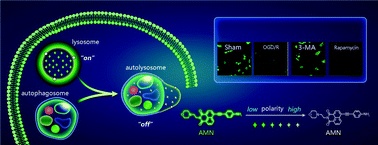An ultrasensitive polarity-specific two-photon probe for revealing autophagy in live cells during scrap leather-induced neuroinflammation process†
Abstract
A polarity-sensitive fluorescence probe AMN was developed to demonstrate the role of autophagy inhibitory drugs in the process of leather residue-induced neuroinflammation, promoting the knowledge of the relationship between autophagy and neuroinflammation. AMN showed a turn-on fluorescent signal in the process of autophagy inhibition via two-photon confocal imaging, which is different from the current popular autophagy probes. Therefore, AMN can offer high-sensitive imaging analysis of the autophagy inhibition process to better understand the role of autophagy in the process of neuroinflammation. The model of scrap leather-induced neuroinflammation using PC12 cells demonstrated that neuroinflammation can induce autophagy by releasing reactive oxygen species (ROS), and autophagy can alleviate neuroinflammation significantly via ROS scavenging.



 Please wait while we load your content...
Please wait while we load your content...